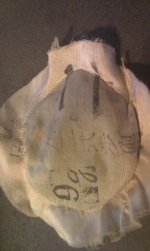Kingkhaos1988
Inactive
Hi I am really not sure where to post this if there is even a proper section at all, but I was reffed here by a member of another forum because they thought it possibly had something to do with a mortar or something of the sort. But I have a small white pouch with powder inside of it, that so far seems to be from WW2 era Japan. I have gotten some general guesses on what it could be on the other forum, but would really like to find out what it actually is. The bag is small white about the size of my palm, and has Japanese words on it, as well as 2 crossing Cannons which I was told is the mark of the Okasa Arsenal in Tokyo, and Also has what looks to be a 9g stamped mark. I will upload a picture so that no one will have to rely on my terrible description alone lol. Thank you so much for any help you can give me in finding out what this is.

